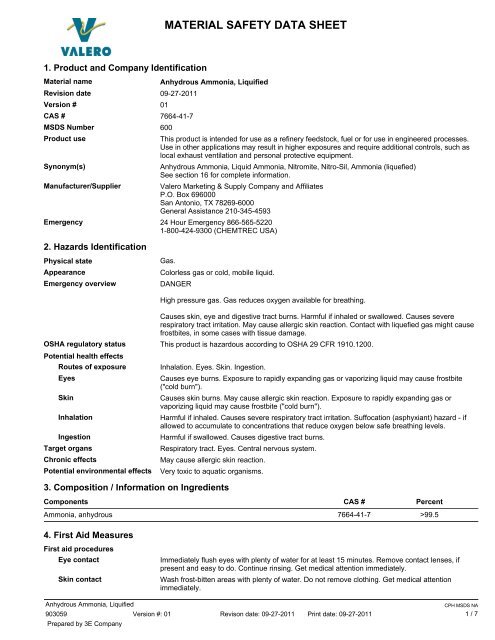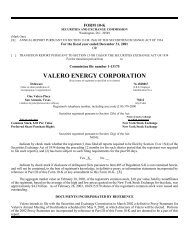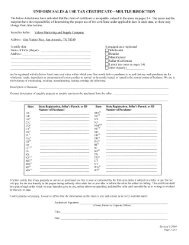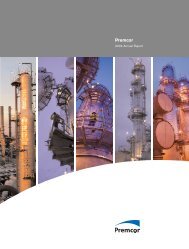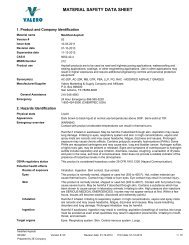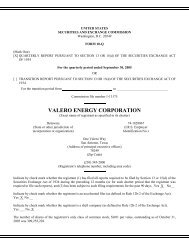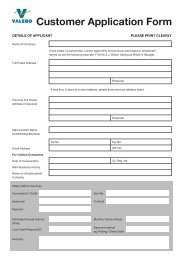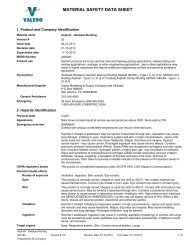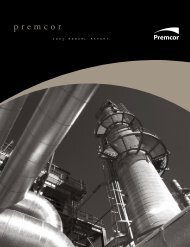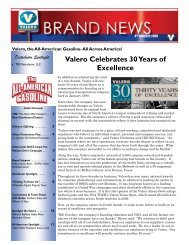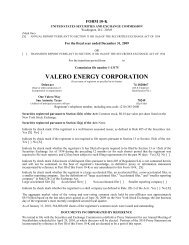MATERIAL SAFETY DATA SHEET - Valero
MATERIAL SAFETY DATA SHEET - Valero
MATERIAL SAFETY DATA SHEET - Valero
Create successful ePaper yourself
Turn your PDF publications into a flip-book with our unique Google optimized e-Paper software.
<strong>MATERIAL</strong> <strong>SAFETY</strong> <strong>DATA</strong> <strong>SHEET</strong><br />
1. Product and Company Identification<br />
Material name<br />
Anhydrous Ammonia, Liquified<br />
Revision date 09-27-2011<br />
Version # 01<br />
CAS # 7664-41-7<br />
MSDS Number 600<br />
Product use<br />
This product is intended for use as a refinery feedstock, fuel or for use in engineered processes.<br />
Use in other applications may result in higher exposures and require additional controls, such as<br />
local exhaust ventilation and personal protective equipment.<br />
Synonym(s)<br />
Anhydrous Ammonia, Liquid Ammonia, Nitromite, Nitro-Sil, Ammonia (liquefied)<br />
See section 16 for complete information.<br />
Manufacturer/Supplier<br />
<strong>Valero</strong> Marketing & Supply Company and Affiliates<br />
P.O. Box 696000<br />
San Antonio, TX 78269-6000<br />
General Assistance 210-345-4593<br />
Emergency 24 Hour Emergency 866-565-5220<br />
1-800-424-9300 (CHEMTREC USA)<br />
2. Hazards Identification<br />
Physical state<br />
Appearance<br />
Emergency overview<br />
Gas.<br />
Colorless gas or cold, mobile liquid.<br />
DANGER<br />
High pressure gas. Gas reduces oxygen available for breathing.<br />
Causes skin, eye and digestive tract burns. Harmful if inhaled or swallowed. Causes severe<br />
respiratory tract irritation. May cause allergic skin reaction. Contact with liquefied gas might cause<br />
frostbites, in some cases with tissue damage.<br />
OSHA regulatory status This product is hazardous according to OSHA 29 CFR 1910.1200.<br />
Potential health effects<br />
Routes of exposure Inhalation. Eyes. Skin. Ingestion.<br />
Eyes<br />
Skin<br />
Inhalation<br />
Ingestion<br />
Target organs<br />
Chronic effects<br />
Potential environmental effects<br />
Causes eye burns. Exposure to rapidly expanding gas or vaporizing liquid may cause frostbite<br />
("cold burn").<br />
Causes skin burns. May cause allergic skin reaction. Exposure to rapidly expanding gas or<br />
vaporizing liquid may cause frostbite ("cold burn").<br />
Harmful if inhaled. Causes severe respiratory tract irritation. Suffocation (asphyxiant) hazard - if<br />
allowed to accumulate to concentrations that reduce oxygen below safe breathing levels.<br />
Harmful if swallowed. Causes digestive tract burns.<br />
Respiratory tract. Eyes. Central nervous system.<br />
May cause allergic skin reaction.<br />
Very toxic to aquatic organisms.<br />
3. Composition / Information on Ingredients<br />
Components CAS # Percent<br />
Ammonia, anhydrous<br />
7664-41-7 >99.5<br />
4. First Aid Measures<br />
First aid procedures<br />
Eye contact<br />
Skin contact<br />
Immediately flush eyes with plenty of water for at least 15 minutes. Remove contact lenses, if<br />
present and easy to do. Continue rinsing. Get medical attention immediately.<br />
Wash frost-bitten areas with plenty of water. Do not remove clothing. Get medical attention<br />
immediately.<br />
Anhydrous Ammonia, Liquified<br />
903059 Version #: 01 Revison date: 09-27-2011 Print date: 09-27-2011<br />
Prepared by 3E Company<br />
CPH MSDS NA<br />
1 / 7
Inhalation<br />
Ingestion<br />
Notes to physician<br />
5. Fire Fighting Measures<br />
Flammable properties<br />
Extinguishing media<br />
Suitable extinguishing<br />
media<br />
Fire fighting<br />
equipment/instructions<br />
Hazardous combustion<br />
products<br />
Move to fresh air. If breathing is difficult, give oxygen. If not breathing, give artificial respiration.<br />
Call a physician or poison control center immediately.<br />
Call a physician or poison control center immediately. DO NOT induce vomiting. If victim is fully<br />
conscious, give a cupful of water. Never give anything by mouth to an unconscious person. If<br />
vomiting occurs, keep head lower than the hips to help prevent aspiration.<br />
Treat symptomatically.<br />
Heat may cause the containers to explode.<br />
Dry chemical, CO2, water spray, fog, or foam.<br />
Self-contained breathing apparatus, operated in positive pressure mode and full protective<br />
clothing must be worn in case of fire.<br />
Move container from fire area if it can be done without risk.<br />
Nitrogen oxides.<br />
6. Accidental Release Measures<br />
Personal precautions<br />
Evacuate the area promptly. No action shall be taken involving any personal risk or without<br />
suitable training. Keep unnecessary personnel away.<br />
Environmental precautions<br />
Methods for cleaning up<br />
7. Handling and Storage<br />
Handling<br />
Storage<br />
Ensure adequate ventilation. In case of inadequate ventilation, use respiratory protection. Wear<br />
appropriate personal protective equipment (See Section 8).<br />
Should not be released into the environment. Prevent further leakage or spillage if safe to do so.<br />
Prevent from entering into soil, ditches, sanitary sewers, waterways and/or groundwater.<br />
Ventilate well, stop flow of gas or liquid if possible. Immediately contact emergency personnel.<br />
Wear appropriate personal protective equipment (See Section 8). Eating, drinking, and smoking<br />
should be prohibited in areas where this material is handled, stored, and processed. Do not<br />
breathe gas. Do not get in eyes, on skin, on clothing. Use only with adequate ventilation.<br />
Store in accordance with local, regional, national, and international regulations. Secure cylinders<br />
in an upright position at all times, close all valves when not in use. Store in a cool, dry,<br />
well-ventilated place. Keep container tightly closed and sealed until ready for use. Protect<br />
cylinders from damage.<br />
8. Exposure Controls / Personal Protection<br />
Occupational exposure limits<br />
US. ACGIH Threshold Limit Values<br />
Components<br />
Type<br />
Value<br />
Ammonia, anhydrous<br />
STEL<br />
35 ppm<br />
(7664-41-7)<br />
TWA<br />
25 ppm<br />
US. OSHA Table Z-1 Limits for Air Contaminants (29 CFR 1910.1000)<br />
Components<br />
Type<br />
Value<br />
Ammonia, anhydrous<br />
(7664-41-7)<br />
PEL<br />
35 mg/m3<br />
50 ppm<br />
Canada. Alberta OELs (Occupational Health & Safety Code, Schedule 1, Table 2)<br />
Components<br />
Type<br />
Value<br />
Ammonia, anhydrous<br />
(7664-41-7)<br />
STEL<br />
TWA<br />
24 mg/m3<br />
35 ppm<br />
17 mg/m3<br />
25 ppm<br />
Anhydrous Ammonia, Liquified<br />
903059 Version #: 01 Revison date: 09-27-2011 Print date: 09-27-2011<br />
Prepared by 3E Company<br />
CPH MSDS NA<br />
2 / 7
Canada. British Columbia OELs. (Occupational Exposure Limits for Chemical Substances, Occupational Health and<br />
Safety Regulation 296/97, as amended)<br />
Components<br />
Type<br />
Value<br />
Ammonia, anhydrous<br />
STEL<br />
35 ppm<br />
(7664-41-7)<br />
TWA<br />
25 ppm<br />
Canada. Ontario OELs. (Ministry of Labor - Control of Exposure to Biological or Chemical Agents)<br />
Components<br />
Type<br />
Value<br />
Ammonia, anhydrous<br />
(7664-41-7)<br />
STEL<br />
24 mg/m3<br />
35 ppm<br />
TWA<br />
17 mg/m3<br />
25 ppm<br />
Canada. Quebec OELS. (Ministry of Labor - Regulation Respecting the Quality of the Work Environment)<br />
Components<br />
Type<br />
Value<br />
Ammonia, anhydrous<br />
(7664-41-7)<br />
STEL<br />
TWA<br />
Mexico. Occupational Exposure Limit Values<br />
Components<br />
Type<br />
Ammonia, anhydrous<br />
(7664-41-7)<br />
Engineering controls<br />
Personal protective equipment<br />
Eye / face protection<br />
Skin protection<br />
Respiratory protection<br />
General hygiene<br />
considerations<br />
9. Physical & Chemical Properties<br />
STEL<br />
TWA<br />
24 mg/m3<br />
35 ppm<br />
17 mg/m3<br />
25 ppm<br />
Value<br />
27 mg/m3<br />
35 ppm<br />
18 mg/m3<br />
25 ppm<br />
Use process enclosures, local exhaust ventilation, or other engineering controls to control<br />
airborne levels below recommended exposure limits. The engineering controls also need to keep<br />
gas, vapor, or dust concentrations below any lower explosive limits.<br />
Wear approved safety glasses or goggles.<br />
Wear protective clothing appropriate for the risk of exposure.<br />
Appearance<br />
Colorless gas or cold, mobile liquid.<br />
Color<br />
Colorless<br />
Odor<br />
Penetrating odor.<br />
Odor threshold<br />
Not available.<br />
Physical state<br />
Gas.<br />
Form<br />
Gas or liquid.<br />
pH<br />
Not available.<br />
Melting point<br />
Not available.<br />
Freezing point<br />
-108 °F (-77.77 °C)<br />
Boiling point<br />
-44 - 11.1 °F (-42.2 - -11.6 °C)<br />
Flash point<br />
Not available.<br />
Evaporation rate<br />
Not available.<br />
Flammability limits in air, upper, 28 %<br />
% by volume<br />
Flammability limits in air, lower, 15 %<br />
% by volume<br />
If engineering controls do not maintain airborne concentrations below recommended exposure<br />
limits (where applicable) or to an acceptable level (in countries where exposure limits have not<br />
been established), an approved respirator must be worn.<br />
Do not eat, drink or smoke when using the product. Wash thoroughly after handling. Provide<br />
eyewash station and safety shower. Handle in accordance with good industrial hygiene and safety<br />
practices.<br />
Anhydrous Ammonia, Liquified<br />
903059 Version #: 01 Revison date: 09-27-2011 Print date: 09-27-2011<br />
Prepared by 3E Company<br />
CPH MSDS NA<br />
3 / 7
Vapor pressure<br />
Not available.<br />
Vapor density 0.6<br />
Specific gravity 0.682<br />
Solubility (water)<br />
Partially soluble.<br />
Partition coefficient<br />
Not available.<br />
(n-octanol/water)<br />
Auto-ignition temperature 1204 °F (651.11 °C)<br />
Decomposition temperature Not available.<br />
Molecular weight<br />
17.04 g/mol<br />
Molecular formula<br />
NH3<br />
10. Chemical Stability & Reactivity Information<br />
Chemical stability<br />
Conditions to avoid<br />
Incompatible materials<br />
Hazardous decomposition<br />
products<br />
Possibility of hazardous<br />
reactions<br />
11. Toxicological Information<br />
Toxicological information<br />
Acute effects<br />
Sensitization<br />
12. Ecological Information<br />
Stable under normal temperature conditions and recommended use.<br />
In a fire or if heated, a pressure increase will occur and the container may burst or explode.<br />
Oxidizing agents. Reducing agents. Acids.<br />
None known.<br />
Polymerization will not occur.<br />
Inhalation exposure produces upper airway, eyes, nose, and throat irritation at concentrations<br />
around 25 ppm. Inhalation of concentrations of greater than 500 ppm can result in pulmonary<br />
edema, acute congestion, bronchitis, and pneumonia; depending on the concentration and the<br />
ndividual. Exposure to high gas concentrations may cause temporary blindness and severe eye<br />
damage.<br />
Causes severe skin, eye and digestive tract burns. Harmful if inhaled or swallowed. Causes<br />
severe respiratory tract irritation. Suffocation (asphyxiant) hazard - if allowed to accumulate to<br />
concentrations that reduce oxygen below safe breathing levels. Exposure to rapidly expanding<br />
gas or vaporizing liquid may cause frostbite ("cold burn").<br />
May cause an allergic skin reaction.<br />
Ecotoxicological data<br />
Components<br />
Ammonia, anhydrous (7664-41-7)<br />
Test Results<br />
LC50 Carp (Hypophthalmichthys nobilis): 0.3 mg/l 96 hours<br />
Ecotoxicity<br />
Persistence and<br />
degradability<br />
Bioaccumulation /<br />
Accumulation<br />
Partition coefficient<br />
(n-octanol/water)<br />
Mobility in environmental<br />
media<br />
Very toxic to aquatic organisms.<br />
Not available.<br />
No data available.<br />
Not available.<br />
No data available.<br />
13. Disposal Considerations<br />
Disposal instructions<br />
14. Transport Information<br />
DOT<br />
Basic shipping requirements:<br />
UN number<br />
UN1005<br />
Proper shipping name Ammonia, anhydrous<br />
Dispose in accordance with all applicable regulations. Empty containers may contain product<br />
residues. Do not puncture or incinerate even when empty. This material and/or its container must<br />
be disposed of as hazardous waste. Return the empty cylinder to the supplier.<br />
Anhydrous Ammonia, Liquified<br />
903059 Version #: 01 Revison date: 09-27-2011 Print date: 09-27-2011<br />
Prepared by 3E Company<br />
CPH MSDS NA<br />
4 / 7
Hazard class<br />
Labels required<br />
Additional information:<br />
2.2<br />
2.2<br />
Special provisions<br />
13, T50<br />
Packaging exceptions None<br />
Packaging non bulk 304<br />
Packaging bulk<br />
314, 315<br />
ERG number<br />
125<br />
DOT BULK<br />
Basic shipping requirements:<br />
UN number<br />
UN1005<br />
Proper shipping name Ammonia, anhydrous<br />
Hazard class<br />
2.2<br />
Labels required<br />
2.2<br />
Additional information:<br />
Special provisions<br />
13, T50<br />
Packaging exceptions None<br />
Packaging non bulk 304<br />
Packaging bulk<br />
314, 315<br />
ERG number<br />
125<br />
IATA<br />
Basic shipping requirements:<br />
UN number<br />
1005<br />
Proper shipping name Ammonia, anhydrous<br />
Hazard class<br />
2.3<br />
Subsidiary hazard class 8<br />
Environmental hazards<br />
Marine pollutant<br />
Yes<br />
Additional information:<br />
ERG code<br />
2CP<br />
IMDG<br />
Basic shipping requirements:<br />
UN number<br />
1005<br />
Proper shipping name AMMONIA, ANHYDROUS<br />
Hazard class<br />
2.3<br />
Subsidiary hazard class 8<br />
Environmental hazards<br />
Marine pollutant<br />
Yes<br />
EmS No.<br />
F-C, S-U<br />
TDG<br />
Basic shipping requirements:<br />
Proper shipping name AMMONIA, ANHYDROUS<br />
Hazard class<br />
2.2<br />
UN number<br />
UN1005<br />
15. Regulatory Information<br />
US federal regulations<br />
This product is a "Hazardous Chemical" as defined by the OSHA Hazard Communication<br />
Standard, 29 CFR 1910.1200.<br />
All components are on the U.S. EPA TSCA Inventory List.<br />
TSCA Section 12(b) Export Notification(40 CFR 707, Subpt. D)<br />
Not regulated.<br />
US EPCRA (SARA Title III) Section 302 - Extremely Hazardous Spill: Reportable quantity<br />
Ammonia, anhydrous (CAS 7664-41-7)<br />
100 LBS<br />
US EPCRA (SARA Title III) Section 302 - Extremely Hazardous Substance: Threshold Planning Quantity<br />
Ammonia, anhydrous (CAS 7664-41-7)<br />
500 LBS<br />
Anhydrous Ammonia, Liquified<br />
903059 Version #: 01 Revison date: 09-27-2011 Print date: 09-27-2011<br />
Prepared by 3E Company<br />
CPH MSDS NA<br />
5 / 7
US EPCRA (SARA Title III) Section 313 - Toxic Chemical: De minimis concentration<br />
Ammonia, anhydrous (CAS 7664-41-7) 1.0 %<br />
US EPCRA (SARA Title III) Section 313 - Toxic Chemical: Listed substance<br />
Ammonia, anhydrous (CAS 7664-41-7)<br />
Listed.<br />
CERCLA (Superfund) reportable quantity (lbs) (40 CFR 302.4)<br />
Ammonia, anhydrous: 100<br />
Superfund Amendments and Reauthorization Act of 1986 (SARA)<br />
Hazard categories<br />
Immediate Hazard - Yes<br />
Delayed Hazard - No<br />
Fire Hazard - No<br />
Pressure Hazard - Yes<br />
Reactivity Hazard - No<br />
Section 302 extremely Yes<br />
hazardous substance (40<br />
CRF 355, Appendix A)<br />
Section 311/312 (40 CFR<br />
370)<br />
Clean Water Act (CWA) Section<br />
112(r) (40 CRF 68.130)<br />
Drug Enforcement<br />
Administration (DEA) (21 CFR<br />
1308.11-15)<br />
Canadian regulations<br />
WHMIS status<br />
WHMIS classification<br />
WHMIS labeling<br />
Yes<br />
Hazardous substance<br />
Not controlled<br />
This product has been classified in accordance with the hazard criteria of the CPR and the MSDS<br />
contains all the information required by the CPR.<br />
Controlled<br />
A - Compressed Gas<br />
D2B - Other Toxic Effects-TOXIC<br />
E - Corrosive<br />
Inventory status<br />
Country(s) or region Inventory name On inventory (yes/no)*<br />
Australia<br />
Australian Inventory of Chemical Substances (AICS)<br />
Yes<br />
Canada<br />
Domestic Substances List (DSL)<br />
Yes<br />
Canada<br />
Non-Domestic Substances List (NDSL)<br />
No<br />
China<br />
Inventory of Existing Chemical Substances in China (IECSC)<br />
Yes<br />
Europe<br />
Europe<br />
European Inventory of Existing Commercial Chemical<br />
Substances (EINECS)<br />
European List of Notified Chemical Substances (ELINCS)<br />
Yes<br />
No<br />
Japan<br />
Inventory of Existing and New Chemical Substances (ENCS)<br />
Yes<br />
Korea<br />
Existing Chemicals List (ECL)<br />
Yes<br />
New Zealand<br />
New Zealand Inventory<br />
Yes<br />
Philippines<br />
United States & Puerto Rico<br />
Philippine Inventory of Chemicals and Chemical Substances<br />
(PICCS)<br />
Toxic Substances Control Act (TSCA) Inventory<br />
Yes<br />
Yes<br />
*A "Yes" indicates that all components of this product comply with the inventory requirements administered by the governing country(s)<br />
State regulations<br />
US - California Hazardous Substances (Director's): Listed substance<br />
Ammonia, anhydrous (CAS 7664-41-7)<br />
Listed.<br />
US - Massachusetts RTK - Substance: Listed substance<br />
Ammonia, anhydrous (CAS 7664-41-7)<br />
Listed.<br />
US - New Jersey Community RTK (EHS Survey): Reportable threshold<br />
Ammonia, anhydrous (CAS 7664-41-7)<br />
500 LBS<br />
Anhydrous Ammonia, Liquified<br />
903059 Version #: 01 Revison date: 09-27-2011 Print date: 09-27-2011<br />
Prepared by 3E Company<br />
CPH MSDS NA<br />
6 / 7
US - New Jersey RTK - Substances: Listed substance<br />
Ammonia, anhydrous (CAS 7664-41-7)<br />
Listed.<br />
US - Pennsylvania RTK - Hazardous Substances: Listed substance<br />
Ammonia, anhydrous (CAS 7664-41-7)<br />
Listed.<br />
16. Other Information<br />
Further information<br />
Other information<br />
HMIS® ratings Health: 3<br />
Flammability: 1<br />
Physical hazard: 0<br />
NFPA ratings Health: 3<br />
Flammability: 1<br />
Instability: 0<br />
HMIS® is a registered trade and service mark of the NPCA.<br />
Note: This Material Safety Data Sheet applies to the listed products and synonym descriptions for<br />
Hazard Communication purposes only. Technical Specifications vary greatly depending on the<br />
products and are not reflected in this document. Consult specification sheets for technical<br />
information.<br />
Disclaimer<br />
This Material Safety Data Sheet (MSDS) was prepared in accordance with 29 CFR 1910.1200 by<br />
<strong>Valero</strong> Marketing & Supply Co., ("VALERO"). VALERO does not assume any liability arising out of<br />
product use by others. The information, recommendations, and suggestions presented in this<br />
MSDS are based upon test results and data believed to be reliable. The end user of the product<br />
has the responsibility for evaluating the adequacy of the data under the conditions of use,<br />
determining the safety, toxicity and suitability of the product under these conditions, and obtaining<br />
additional or clarifying information where uncertainty exists. No guarantee expressed or implied is<br />
made as to the effects of such use , the results to be obtained, or the safety and toxicity of the<br />
product in any specific application. Furthermore, the information herein is not represented as<br />
absolutely complete, since it is not practicable to provide all the scientific and study information in<br />
the format of this document, plus additional information may be necessary under exceptional<br />
conditions of use, or because of applicable laws or government regulations.<br />
Issue date 09-27-2011<br />
Anhydrous Ammonia, Liquified<br />
903059 Version #: 01 Revison date: 09-27-2011 Print date: 09-27-2011<br />
Prepared by 3E Company<br />
CPH MSDS NA<br />
7 / 7


